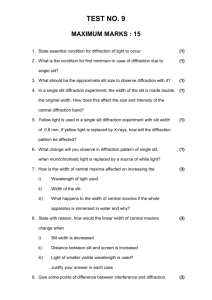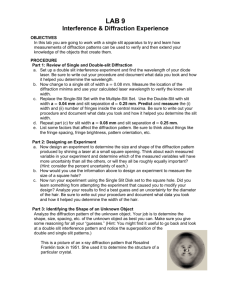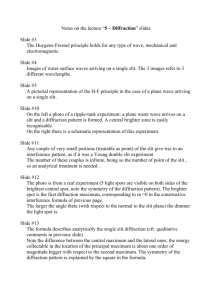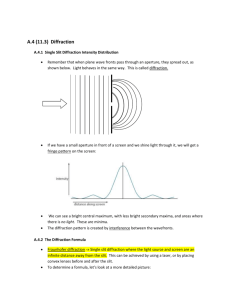Diffraction Lab worksheet Key
advertisement
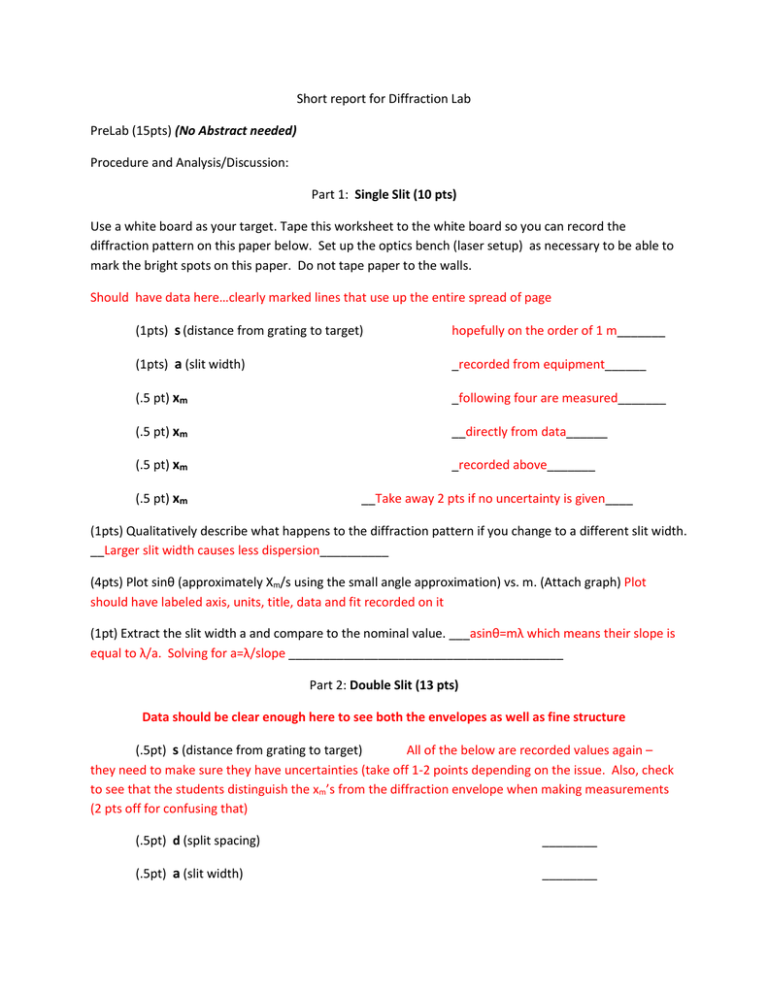
Short report for Diffraction Lab PreLab (15pts) (No Abstract needed) Procedure and Analysis/Discussion: Part 1: Single Slit (10 pts) Use a white board as your target. Tape this worksheet to the white board so you can record the diffraction pattern on this paper below. Set up the optics bench (laser setup) as necessary to be able to mark the bright spots on this paper. Do not tape paper to the walls. Should have data here…clearly marked lines that use up the entire spread of page (1pts) s (distance from grating to target) hopefully on the order of 1 m_______ (1pts) a (slit width) _recorded from equipment______ (.5 pt) xm _following four are measured_______ (.5 pt) xm __directly from data______ (.5 pt) xm _recorded above_______ (.5 pt) xm __Take away 2 pts if no uncertainty is given____ (1pts) Qualitatively describe what happens to the diffraction pattern if you change to a different slit width. __Larger slit width causes less dispersion__________ (4pts) Plot sinθ (approximately Xm/s using the small angle approximation) vs. m. (Attach graph) Plot should have labeled axis, units, title, data and fit recorded on it (1pt) Extract the slit width a and compare to the nominal value. ___asinθ=mλ which means their slope is equal to λ/a. Solving for a=λ/slope ________________________________________ Part 2: Double Slit (13 pts) Data should be clear enough here to see both the envelopes as well as fine structure (.5pt) s (distance from grating to target) All of the below are recorded values again – they need to make sure they have uncertainties (take off 1-2 points depending on the issue. Also, check to see that the students distinguish the xm’s from the diffraction envelope when making measurements (2 pts off for confusing that) (.5pt) d (split spacing) ________ (.5pt) a (slit width) ________ (.5 pt) xm ________ (.5 pt) xm ________ (.5 pt) xm ________ (.5 pt) xm ________ (1pts) Diffraction envelope minimum ________ (.5 pt) Second mimima ________ (1pts) Qualitatively describe what happens to the diffraction pattern if you change to a different slit width. Increasing the slit width decreases the envelope spacing___________ (1pts) Qualitatively describe what happens to the diffraction pattern if you change to a different slit spacing. Increasing the slit spacing decreases the fine structure spacing__________________________ (4pts) Plot sinθ (approximately Xm/s using the small angle approximation) vs. m. (Attach graph) Same plot requirements (1pt) Extract the slit width a and compare to the nominal value. Watch for confusion between envelope and xm’s in these calculations as well_______ (1pt) Extract the slit spacing d and compare to the nominal value. See above____________ Part three: Diffraction Gratings (9pts) Should have equally spaced dots here (.5pt) s (distance from grating to target) again values recorded from measurements_ (.5pt) d (lines/mm) ________ (.5 pt) xm ________ (.5 pt) xm ________ (.5 pt) xm ________ (.5 pt) xm ________ (4pts) Plot sinθ (approximately Xm/s using the small angle approximation) vs. m. (Attach graph) See above for grading (1pt) Extract the wavelength (λ) and compare to nominal value (6328 Å). λ=m/slope______________ (1pt) Qualitatively describe what happens to the diffraction pattern if you have more lines per millimeter. What happens if you have fewer lines per millimeter? Increase lines/mm means there will be a greater spread in the dispersion of dots (3pts) Use the laser to find the diffraction pattern of a single piece of hair. Describe your procedure briefly below and give the determined thickness of the hair measured. Is your value reasonable? Now repeat with different hairs (either from different places on one volunteer’s head or from different volunteers). What variability in hair thickness do you find? Procedure should be nearly identical to the single slit experiment. Students should explain procedure (1 pt), have data (1pt) and give a final, reasonable number (50-200 microns) (1pt) _______

